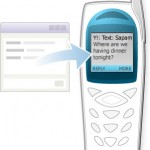The various acronyms used to describe the different kind of text messaging services are not always intuitive and can be confusing to new users. Hopefully the following breakdown of the three most popular messaging services will help clear things up.
1. SMS

SMS stands for Short Message Service and is the most widely used type of text messaging. With a SMS, you can send a message of up to 160 characters to another device. Longer messages can be split up into several parts. Most cell phones support this type of text messaging, and sending a SMS is usually very cheap. SMSs can also be used to access various services from a portable device, such as Google and MSN. Spam sent as SMS is also becoming more common.
2. EMS
EMS means Enhanced Messaging Service and is an extension of the SMS. It provides SMS with functionalities such as text formatting (bold or italic fonts) and limited picture and animation support. If an EMS is sent to a phone that doesn’t support it, it will display as a standard SMS. EMS will probably be rendered obsolete by MMS.
3. MMS
MMS stands for Multimedia Messaging Service and this type of text messaging is an evolution of the SMS. With a MMS, you can send a message including pictures, video or audio content to another device. It is very useful to send a photo taken with a camera phone to another phone. Most new cell phones with multimedia capabilities support MMS. Because the size of the message is defined in kilobytes, a MMS can contain a lot more information than a SMS. Be careful, carriers can sometimes charge high fees for data transfer over their network if it’s not included in your plan.
Now get to your keypads and start typing!

Leave a Reply